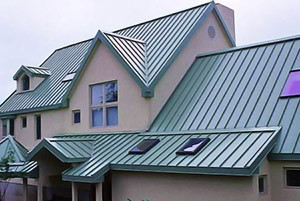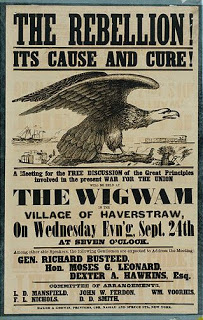
Underground Railroad: Seward House
While recently investigating the dismal record of the more-or-less defunct Amistad Commission that was the subject of two posts, I came across the Underground Railroad on the website of the NYSOPRHP. That subject was a topic of an earlier post on March 6, 2014, Resurrecting the NY Freedom Trail about efforts in Manhattan to create a freedom trail.
The New York State Freedom Trail today is perhaps even less well-known than the New York State Amistad Commission. It began as a state project with similar high hopes and followed the same trajectory to substandard results.
The New York State Freedom Trail Act of 1997 proposed the establishment of a Freedom Trail Commission to plan and implement a New York State Freedom Trail program to commemorate these acts of freedom and to foster public understanding of their significance in New York State history and heritage.
There was an Underground Railroad traveling exhibit “Journey to the North: New York’s Freedom Trail” which could be borrowed by contacting Cordell Reaves who does still work at the OPRHP. There were hundreds of sites identified. There was a commission which was to issue annual reports to the Board of Regents. The State Education Department supported it unlike with the future Amistad Commission. So what happened? Where are these reports? What action has been taken?
The regulations which is still on the books states:
§ 233-b. New York state freedom trail commission. 1. a. There is hereby established within the department [of Education] the New York state freedom trail commission. The commission shall consist of twelve members, to be appointed as follows: three members to be appointed by the governor, three members to be appointed by the board of regents, two members to be appointed by the temporary president of the senate, one member to be appointed by the minority leader of the senate, two members to be appointed by the speaker of the assembly, and one member to be appointed by the minority leader of the assembly. Such members shall be representative of academic or public historians, corporations, foundations, historical societies, civic organizations, and religious denominations. In addition, the following state officers, or their designees, shall serve as members of the commission: the commissioner of education, the head of the state museum, the head of the state archives, the head of the office of state history, the commissioner of economic development, the head of the state tourism advisory council and the commissioner of parks, recreation and historic preservation.
Impressive group isn’t it? Assemblyman Englebright has gotten nowhere with his attempt to create a state history committee that brings together precisely these state organizations and here the regulation does that but only for the Underground Railroad.
Just as the Department of Education was supposed to provide the support for the Amistad Commission, the OPRHP was to for the Underground Railroad Commission. There was to be a master plan including “sponsoring commemorations, linkages, seminars and public forum[s].” There were to be annual reports for five years beginning no later than 1999 so perhaps it was intended to die in 2004 even though it was never repealed.
Clearly nothing happened afterwards but did anything happen even after the regulation went into effect? A FOIL request in 2016 to the State Education Department was forwarded to the State Historian and produced the following response:
The New York State Museum History Office has no records pertaining to the New York State Freedom Trail Commission. I am under the impression that the New York State Parks, Recreation, and Historic Preservation were involved with this commission. Also note that there is a published book on the commission that may be helpful: New York State Freedom Trail Program Study: Report to the New York State Freedom Trail Commission, published by the Schomburg Center for Research in Black Culture, 1999.
That report was initiated in 1997. I have a copy of it as I attended a meeting when it was later released. It is not one of the annual reports required by the regulation. The answer as to what happened after the regulation went into effect appears to be that the Freedom Commission like the Amistad Commision like the Heritage Areas like the Path through History was a project of regulations and press releases but devoid of substance.
So let’s see what is going on now. I started with the Parks website. Since Parks was the designated support department, that’s where the website ended up. I clicked on
Discover the many important historic sites, museums and interpretive centers related to Underground Railroad, slavery and anti-slavery themes in New York State which took me to a non-New York State government website. The map contained many hotspots presumably where underground railroad sites are to be located. I selected the Albany flag. I did so because Paul and Mary Liz Stewart, co-founders of The Stephen and Harriet Myers Residence and The Underground Railroad History Project in the Capital Region have participated in IHARE Teacherhostels/ Historyhostels, I have been to the Residence with and without teachers, I see them at various conferences, and it received at $70,000 grant in the 2015 REDC Awards announced last December. I have attended their annual conference but it is not held on the Path through History weekend nor is the one in Peterboro. As you might suspect given this buildup when I clicked on the Albany flag a blank inset box appeared. There was no information at all about any underground railroad site in Albany, just a flag indicating there was. It made it look like the project simply had been abandoned in mid-stream.

The Stephen and Harriet Myers Residence (Lakestolocks)
Paul Stewart did write about the residence:
In a similar spirit, the site doesn’t feel monumental—it feels intimate—and it doesn’t act like a traditional museum—it functions as a center for outreach and generates conversation about a history that continues to demonstrate its relevance as part of a lineage of struggle that can easily be tied to the aims of Martin Luther King, and, in our contemporary world, Black Lives Matter.
But not on the Parks website. Sorry Paul, those black lives don’t matter there.
Then in 2013, a change occurred. As reported in New York History Blog
New Map, App Feature NY Underground Railroad Sites
Federal and state partners have recently released a new online map and mobile app to help people explore New York State’s connection to abolitionism and the Underground Railroad. The map includes sites, programs and tours that have been approved by the National Park Service Network to Freedom Program or the New York State Underground Railroad Heritage Trail.
The New York sites were now part of a national effort led by the National Park Service.
Ruth Pierpont, Deputy Commissioner for Historic Preservation at OPRHP said in a statement issued to the press: “We are happy to partner with the Erie Canalway Heritage Corridor and I Love New York in making this user-friendly map available to promote an understanding of this important, and still under-recognized, aspect of the history of our state.”
This map was available on an app and on the web. So now there were two New York maps of underground railroad sites, one at NYSOPRHP and one which can be accessed through the National Park Service Erie Canal Heritage Corridor if it occurs to someone that for the purposes of the underground railroad in the entire state of New York the Erie Canal Heritage Corridor website is the place to go.
On that map, the Stephen and Harriet Myers Residence can be located by clicking on one of the stars in the Albany region. The website link for the Residence takes you to “Body and Home Improvement” which asks why you should hire a water damage restoration company, the advantages of metal roofing, and Healthy Meal Prep Options: Lemon Pepper Chicken. Keeping links up-to-date can be a challenge especially if no one is responsible for doing it.


Images from website directed to by New York State Network to Freedom -Underground Railroad
Note: The error on the web link has been corrected – “Note: ugrworkshop.com was once associated with the underground workshop. This website is not affiliated in any way with its previous owners.”
I then decided to try the star for the First Congregational Church of Poughkeepsie where I know the Mid-Hudson Anti-Slavery Project meets. Rebecca Edwards, Vassar College, one of the founders, did speak to teachers in a IHARE program and IHARE once helped fund a stop of the Amistad replica in Poughkeepsie. The click on the website link from the map took me to “Oops! That page can’t be found.”
Finally, I tried the one site in Westchester where I live. It is for Philipsburg Manor in Sleepy Hollow which also has participated in IHARE programs. I was a little surprised to see it on an Underground Railroad site since it was Loyalist property that was confiscated after the American Revolution and didn’t exist in the 1800s. The historic site has focused on runaway slave ads from the time slavery was legal in New York and it wasn’t part of the Underground Railroad movement. In this case the link from the Erie Canal Heritage Corridor did work. When I reached the Philipsburg Manor website I did a search on “Underground Railroad” and found nothing which is to be expected.
In case you were wondering, the Stephen and Harriet Myers Residence is not on the Path through History website either. This makes sense since it doesn’t mean the qualifications of I Love NY for a tourist site regardless of its listing on the National Park Service Erie Canal Heritage Corridor map.
There is more that could be written about the New York State Freedom Trail/Underground Railroad Heritage trail with its defunct commission, no staff, inadequate websites, and the lack of support for conferences, public forums, and teacher programs but the point should be clear. Unfunded, dysfunctional, silo organized history projects are standard operating procedure in New York State. Although black lives don’t matter in New York State history it’s not because the State is racist, it is because the State’s ineptitude occurs on an equal opportunity basis.







